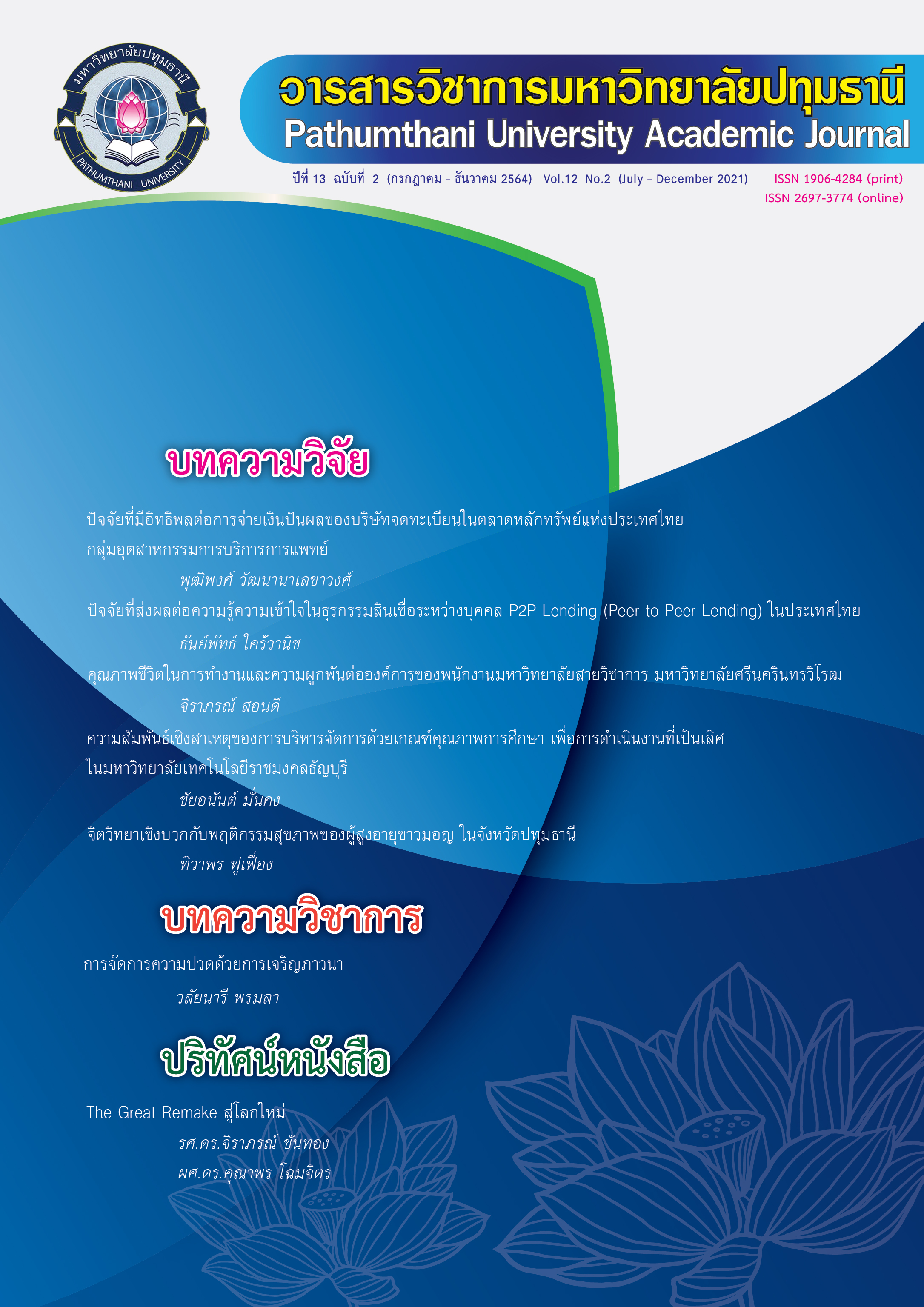EFFECTIVENESS IN VILLAGE AND COMMUNITY FUND MANAGEMENT FOR SUSTAINABILITY OF PATTANI PROVINCE
Keywords:
Village and Community Fund Management, Pattani ProvinceAbstract
The research had objectives were to study the level of effectiveness of the village community fund management for sustainability in Pattani Province. 2. study the level of administrative factors; and 3) study the factors affecting the effectiveness of the village and community fund management for sustainability in Pattani Province. The research was a mixed method. The quantitative research method used questionnaires, data collection from the sample of 336 village fund committees. The statistics used consisted of mean, standard deviation and multiple regression analysis. The qualitative research method used was an interview. The key informants consisted of the president of the municipality, the president of the sub-district administrative organization, the headman and the village and urban community fund management committees, totaling 25 people.
It was found that 1) effectiveness of the village community fund management was at a high level. When considering each aspect in descending order, it was found that the goal was achieved at a high-level satisfaction at a high level The financial aspect is at a high level. internal processes and functions at a high-level learning and development at a high level 2) factors of sustainable village and urban fund management in six aspects that affecting overall sustainable village and urban community fund management effectiveness included goal setting and work planning, team work, loan approval and monitoring work control. The regression coefficients were .47, .42, .51 and .32 respectively, and the prediction coefficient (R2) of .80 were able to predict 80 percent of the outcome. 3) The results of the interview revealed that the achievement of the goals had a target setting, a plan, a follow-up and improvement. Satisfaction Projects had to be formulated in accordance with financial requirements and budgeting as required. There were control and transparency. In terms of internal processes and functions, job goals and roles had to be defined and performance indicators were defined, learning and the need to be a continuous learning form.
References
คะนึงนิจ ศิริสมบูรณ์, ฉันธะ จันทะเสนา และ ดวงตา สราญรมย์. (2553). “ปัจจัยที่มีผลต่อการบริหารกองทุนหมู่บ้านในเขตอำเภอสีคิ้ว จังหวัดนครราชสีมา”. วารสารบัณฑิตศึกษา มหาวิทยาลัยราชภัฏวไลย อลงกรณ์ในพระบรมราชูปถัมภ์. ปีที่ 3 ฉบับที่ 3. หน้า 75-89
ธีรยุทธ พึ่งเทียร. (2546) การบริหารบุคคล. กรุงเทพมหานคร : สูตรไพศาล.
บวรพรรณ อัชกุล และวรวรรณ ชาญด้วยวิทย์. (2550). การประเมินผลกระทบของกองทุน หมู่บ้านต่อความยากจน. เอกสารประกอบการสัมมนาวิชาการประจำปี 2550 เรื่องจะ แก้ปัญหา ความยากจนกันอย่างไร: แข่งขัน แจกจ่าย หรือสวัสดิการ. สถาบันวิจัยเพื่อการ พัฒนา ประเทศไทย.
สำนักงานคณะกรรมการพัฒนาเศรษฐกิจและสังคมแห่งชาติ. (2549) ข้อบังคับกองทุนหมู่บ้าน. กรุงเทพมหานคร : สำนักนายกรัฐมนตรี.
สำนักงานคณะกรรมการกองทุนหมู่บ้าน และชุมชนเมืองแห่งชาติ. (2544ก). คู่มือการดำเนินงาน สำหรับคณะอนุกรรมการสนับสนุนและติดตาม การดำเนินงานกองทุนหมู่บ้านระดับ จังหวัดและ อำเภอ. กรุงเทพมหานคร : สำนักงานคณะกรรมการกองทุนหมู่บ้าน.
สำนักงานกองทุนหมู่บ้านและชุมชนเมืองแห่งชาติ. (2560). รู้จักกองทุนหมู่บ้านและชุมชนเมือง จังหวัดปัตตานี. [ออนไลน์] เข้าถึงได้จาก : http://www.villagefund.or.th/ index. aspx?Pageid=469&parent= 433& directory=1964& pagename= content. เมื่อวันที่ 18 มีนาคม 2563.
Yamane, Taro. (1973). Statistics: An Introductory Analysis. Third editio. Newyork : Harper and Row Publication.
Downloads
Published
How to Cite
Issue
Section
License
บทความที่ได้รับการตีพิมพ์เป็นลิขสิทธิ์ของวารสารมหาวิทยาลัยปทุมธานี
ข้อความที่ปรากฎในบทความแต่ละเรื่อง เป็นความคิดเห็นส่วนตัวของผู้เขียน กองบรรณาธิการไม่จำเป็นต้องเห็นด้วยเสมอไป และไม่มีส่วนรับผิดชอบใด ๆ ถือเป็นความรับผิดชอบของผู้เขียนแต่เพียงผู้เดียว



